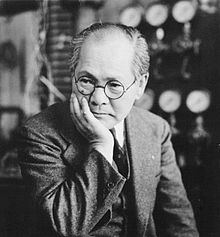Yoshio Nishina
Yoshio Nishina | |
|---|---|
仁科 芳雄 | |
 | |
| Born | December 6, 1890 |
| Died | January 10, 1951 (aged 60) |
| Nationality | Japanese |
| Known for | Klein–Nishina formula |
| Awards | Asahi Prize(1944) Order of Culture(1946) |
| Scientific career | |
| Fields | Physics |
| Institutions | RIKEN |
| Notable students | Hideki Yukawa Sin-Itiro Tomonaga Shoichi Sakata |
Yoshio Nishina (仁科 芳雄, Nishina Yoshio, December 6, 1890 – January 10, 1951) was a Japanese physicist. He was called "the founding father of modern physics research in Japan".
Life

Nishina was born in Satoshō, Okayama, and graduated from Tokyo Imperial University as an electrical engineer in 1918. After graduation, he became a staff member at the Institute of Physical and Chemical Research (now RIKEN).
In 1921, he was sent to Europe for research. He visited some European universities and institutions, including Cavendish Laboratory, Georg August University of Göttingen, and University of Copenhagen. In Copenhagen, he did research with Niels Bohr and they became good friends. In 1928, he wrote a paper on incoherent or Compton scattering with Oskar Klein in Copenhagen, from which the Klein–Nishina formula derives.[1]
In 1929, he returned to Japan, where he endeavored to foster an environment for the study of quantum mechanics. He established Nishina Laboratory at RIKEN in 1931, and invited some Western scholars to Japan including Heisenberg, Dirac and Bohr to stimulate Japanese physicists. His laboratory was severely damaged during World War II and most equipment had to be discarded and rebuilt after the war.[2]
He died from liver cancer in 1951.[1]
The crater Nishina on the Moon is named in his honor.
Work
Nishina co-authored the Klein–Nishina formula. His research was concerned with cosmic rays and particle accelerator development for which he constructed a few cyclotrons at RIKEN. In particular, he detected what turned out to be the muon in cosmic rays, independently of Anderson et al.[1] He also discovered the uranium-237 isotope and pioneered the studies of symmetric fission phenomena occurring upon fast neutron irradiation of uranium (1939–1940).
He was a principal investigator of RIKEN and mentored generations of physicists, including two Nobel Laureates: Hideki Yukawa and Sin-Itiro Tomonaga.
During World War II, he was the head of the Japanese nuclear weapon program.
See also
References
- ^ a b c Sin-Itiro Tomonaga Yoshio Nishina, His Sixtieth Birthday Archived March 26, 2009, at the Wayback Machine, November 20, 1950 (updated January 11, 1951)
- ^ Yoshio Nishina – Father of Modern Physics in Japan. Nishina Foundation
